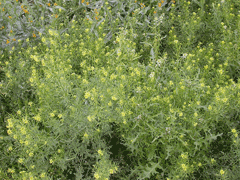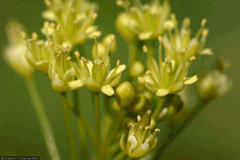 |
|
http://commons.wikimedia.org/wiki/User:Curtis_Clark |
 |
| Patrick J. Alexander @ USDA-NRCS PLANTS Database |
Translate this page:
Summary
Physical Characteristics

 Sisymbrium is a ANNUAL growing to 0.6 m (2ft). It is in flower from June to August, and the seeds ripen from August to September. The species is hermaphrodite (has both male and female organs). The plant is self-fertile.
Sisymbrium is a ANNUAL growing to 0.6 m (2ft). It is in flower from June to August, and the seeds ripen from August to September. The species is hermaphrodite (has both male and female organs). The plant is self-fertile.
Suitable for: light (sandy), medium (loamy) and heavy (clay) soils. Suitable pH: mildly acid, neutral and basic (mildly alkaline) soils. It can grow in semi-shade (light woodland) or no shade. It prefers dry or moist soil.
UK Hardiness Map
US Hardiness Map
Synonyms
Sisymbrium canescens. Walt. Sophia halictorum. S. pinnata.
Plant Habitats
Edible Uses
Young leaves - cooked[46, 61, 85, 94, 183]. A bitter flavour[85]. Eaten as greens in the spring, they are said to have a salty flavour[216, 257]. The seedpods make an interesting mustard-flavoured nibble[183]. Seed - raw or cooked. Used as a piñole[257]. The seed has a mustard flavour and can be used to flavour soups or as a condiment with corn[92, 257]. The seed can also ground into a powder, mixed with cornmeal and used to make bread, or as a thickening for soups etc[85, 92, 94, 183]. In Mexico the seeds are made into a refreshing drink with lime juice, claret and syrup[61, 183]. The seeds are said to taste somewhat like black mustard and were utilized as food by Native American peoples such as the Navajo.
References More on Edible Uses
Medicinal Uses
Plants For A Future can not take any responsibility for any adverse effects from the use of plants. Always seek advice from a professional before using a plant medicinally.
Diuretic, expectorant, poultice[94]. The ground up seeds have been used in the treatment of stomach complaints[257]. A poultice of the plant has been used to ease the pain of toothache[257]. An infusion of the leaves has been used as a wash on sores[257].
References More on Medicinal Uses
The Bookshop: Edible Plant Books
Our Latest books on Perennial Plants For Food Forests and Permaculture Gardens in paperback or digital formats.

Edible Tropical Plants
Food Forest Plants for Hotter Conditions: 250+ Plants For Tropical Food Forests & Permaculture Gardens.
More

Edible Temperate Plants
Plants for Your Food Forest: 500 Plants for Temperate Food Forests & Permaculture Gardens.
More

More Books
PFAF have eight books available in paperback and digital formats. Browse the shop for more information.
Shop Now
Other Uses
The flowers are attractive to butterflies. Tansymustard is toxic to grazing animals in large quantities due to nitrates and thiocyanates; however, it is a nutritious in smaller amounts. See known hazards above.
Special Uses
References More on Other Uses
Cultivation details
We have almost no information on this species but judging by its native range it should succeed in most parts of Britain and is probably not too fussy about soil or situation. We suggest growing it in a dry to moist soil in a sunny position.
References Carbon Farming Information and Carbon Sequestration Information
Temperature Converter
Type a value in the Celsius field to convert the value to Fahrenheit:
Fahrenheit:
The PFAF Bookshop
Plants For A Future have a number of books available in paperback and digital form. Book titles include Edible Plants, Edible Perennials, Edible Trees,Edible Shrubs, Woodland Gardening, and Temperate Food Forest Plants. Our new book is Food Forest Plants For Hotter Conditions (Tropical and Sub-Tropical).
Shop Now
Plant Propagation
Seed - sow spring in situ.
Other Names
If available other names are mentioned here
Tansy mustard, Mountain tansy mustard, Tansy Mustard, Western tansymustard, Menzies' tansymustard, Nelson's tansymustard, Payson's tansymustard
Native Range
NORTHERN AMERICA: Canada (Northwest Territories, Québec, Ontario, Saskatchewan, Alberta, Manitoba, British Columbia, Nunavut), United States (Indiana, Michigan, New Hampshire (north), New York, Ohio, Vermont (north), West Virginia (east), Iowa, Kansas, Minnesota, Missouri, Nebraska, North Dakota, South Dakota, Illinois, Oklahoma, Wisconsin, Colorado (east), Idaho, Montana, Oregon, Washington, Wyoming, Alabama, Arkansas, Florida (north & central), Georgia (east & south), Kentucky (west), Louisiana, North Carolina (east), South Carolina (east), Tennessee, Virginia (east), New Mexico, Texas, Arizona, California, Nevada (west), Utah), Mexico (Baja California (Norte), Baja California Sur, Chihuahua, Coahuila de Zaragoza, Durango, Sinaloa, Sonora, Zacatecas, Michoacán de Ocampo)
Weed Potential
Right plant wrong place. We are currently updating this section.
Please note that a plant may be invasive in one area but may not in your area so it's worth checking.
This plant can be weedy or invasive. Some evidence in Nebraska and Illinois, USA.
Conservation Status
IUCN Red List of Threatened Plants Status : This taxon has not yet been assessed for the IUCN Red List. USDA Threatened and Endangered Information: Ohio, US -
tansy-mustard:
Threatened

Growth: S = slow M = medium F = fast. Soil: L = light (sandy) M = medium H = heavy (clay). pH: A = acid N = neutral B = basic (alkaline). Shade: F = full shade S = semi-shade N = no shade. Moisture: D = dry M = Moist We = wet Wa = water.
Now available:
Food Forest Plants for Mediterranean Conditions
350+ Perennial Plants For Mediterranean and Drier Food Forests and Permaculture Gardens.
[Paperback and eBook]
This is the third in Plants For A Future's series of plant guides for food forests tailored to
specific climate zones. Following volumes on temperate and tropical ecosystems, this book focuses
on species suited to Mediterranean conditions—regions with hot, dry summers and cool, wet winters,
often facing the added challenge of climate change.
Read More
Expert comment
Author
(Walter.)Britton.
Botanical References
60
Links / References
For a list of references used on this page please go here
Readers comment
| Add a comment |
|
If you have important information about this plant that may help other users please add a comment or link below. Only comments or links that are felt to be directly relevant to a plant will be included. If you think a comment/link or information contained on this page is inaccurate or misleading we would welcome your feedback at [email protected]. If you have questions about a plant please use the Forum on this website as we do not have the resources to answer questions ourselves.
* Please note: the comments by website users are not necessarily those held by PFAF and may give misleading or inaccurate information.
To leave a comment please Register or login here All comments need to be approved so will not appear immediately.
|
|